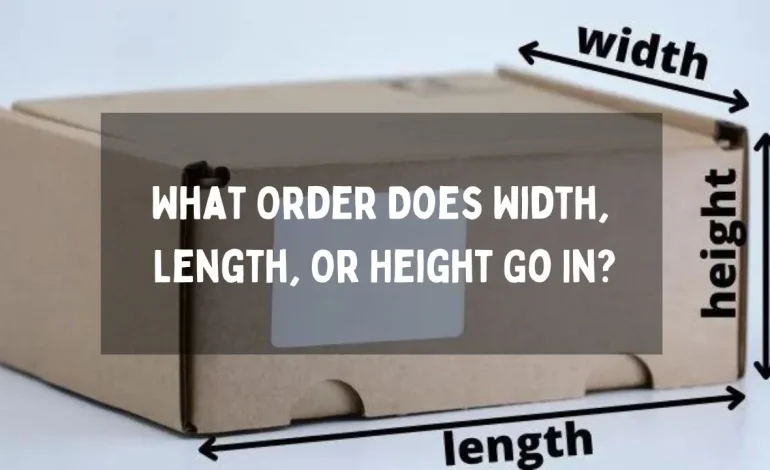
What Order Does Width, Length, Or Height Go In?
Have you ever found yourself perplexed when it comes to the order of width, length, and height? Whether you’re shopping for furniture, measuring a room, or just trying to make sense of product dimensions, understanding the proper sequence of these three dimensions can be a real head-scratcher.
We’ll unravel the mystery behind the order of width, length, and height, demystify terms like W x H x D, and provide insights on measuring everything from rooms to beds.
By the end, you’ll be equipped with the knowledge you need to ensure you’re getting the right-sized product and confidently navigating the world of measurements. So, let’s dive in and put an end to the confusion once and for all!
When 3 dimensions are given what is the order?
When three dimensions are given, the order in which they are typically presented is width, followed by length, and then height. This sequence is commonly used to describe the size and proportions of various objects.
For example: if you’re looking at the dimensions of a cardboard box, it might be listed as 12″ (width) x 18″ (length) x 6″ (height).
This order is consistent in industries like construction, manufacturing, and product packaging, making it crucial to understand to ensure you accurately interpret and work with measurements.
So, the next time you encounter three dimensions, remember W x L x H, and you’ll have the right order at your fingertips.
Also Read: What Are The Benefits Of Using A Shower Curtain Liner?
What order do measurements go in?
When three dimensions are provided, the standard order is width, length, and height. This sequence is commonly used to describe the size and proportions of objects.
For example: If you have a box with dimensions 10 inches in width, 20 inches in length, and 5 inches in height, the order would be represented as W x L x H.
Understanding this order is important for accurately interpreting measurements and working with various objects and products.
What’s the difference between length and width?
| Aspect | Length | Width |
| Definition | The measurement of an object from one end to the other, typically the longer dimension. | The measurement of an object from side to side, typically the shorter dimension. |
| Orientation | Usually represents the longer or longest dimension of an object. | Typically represents the shorter or narrower dimension of an object. |
| Example | In the case of a rectangular table, the length is the dimension along its longest side. | For the same rectangular table, the width is the dimension along its shorter side. |
| Common Usage | Often used to describe the greater extent or span of an object. | Commonly used to refer to the narrower or shorter aspect of an object. |
| Importance in Measurement | Crucial when describing the extent of an object in one direction. | Significant when specifying the narrower or shorter aspect of an object. |
Also Read: Why Is A Shower Curtain Important For Shower Enclosures?
How to make sure you’re getting the right size product?
Ensuring you get the right size product is essential to avoid disappointment and inconvenience.
Here are some steps to follow when making a purchase:
- Know Your Requirements:
- Take Measurements:
- Check the Product’s Dimensions:
- Read Reviews and Ask Questions:
- Size Guides and Charts:
- Consider Future Needs:
- Return and Exchange Policy:
- Compare Models:
- Consult Experts:
- Visualize the Product:
- Order and Inspect:
What if the product doesn’t have any measurements?
When a product doesn’t have any provided measurements, it can be challenging to determine if it will suit your needs.
Here are some steps you can take to address this situation:
- Contact the Seller or Manufacturer:
- Search for Product Documentation:
- Look for Reviews and Discussions:
- Use Reference Objects:
- Visit a Physical Store:
- Check for Size Options:
- Read Return and Exchange Policies:
- Consult with Customer Service:
- Consider the Risk:
What is W x H x D?
“W x H x D” stands for Width x Height x Depth. It’s a common way to represent the three dimensions of an object or space, typically used in product descriptions or architectural plans.
For instance, if you see a product labeled as “10” W x 20″ H x 5″ D,” it means the width is 10 inches, the height is 20 inches, and the depth is 5 inches.
Also Read: Home with Keki Interior Design Blogger
How do you get the square footage of a room?
To calculate the square footage of a room, follow these steps:
- Measure the Length and Width: Using a tape measure, measure the length and width of the room in feet. Ensure that you measure from wall to wall.
- Multiply Length by Width: Multiply the length by the width to get the total square footage. The formula is Square Footage = Length (in feet) x Width (in feet).
- Account for Irregular Shapes: If the room has an irregular shape, divide it into smaller, more manageable rectangles or squares, calculate the square footage of each section, and then sum them up to get the total square footage.
- Include or Exclude Specific Areas: Depending on your needs, you may choose to include or exclude certain areas. For example, you might exclude a closet or hallway if you’re calculating the square footage for flooring or paint.
Also Read: Dream House Modern Duplex House Designs In Nigeria
What are imperial measurements?
Imperial measurements, also known as the British Imperial System, are a system of units for measuring length, weight, volume, and other quantities.
These measurements are primarily used in the United States and some other countries.
Key units in the imperial system include inches, feet, yards, miles (length); pounds and ounces (weight); and gallons (volume).
For example: When you see something measured in inches or feet (e.g., a 12-inch ruler or a 10-foot ladder), it is using the imperial system.
It differs from the metric system, which is used in most of the world and employs units like centimeters, meters, kilograms, and liters.
How is a bed measured?
Beds are typically measured by their mattress size, which is the dimensions of the mattress that fits on the bed frame. The common mattress sizes include Twin, Twin XL, Full, Queen, King, and California King.
For example: A Queen-sized bed typically has a mattress that measures 60 inches in width and 80 inches in length.
Also Read: House Plans With Game Room
What is first length width or height?
When specifying the dimensions of an object, the order is generally Width, Length, and Height (W x L x H). For instance,
if you’re describing a bookshelf, you would provide the width (side to side), followed by the length (front to back), and then the height (top to bottom) as the last dimension.
What is the order of length width and height?
The order of dimensions is typically Length, Width, and Height (L x W x H). For example, when describing a rectangular room, you would first specify the length, then the width, and finally the height.
This order is widely accepted in various industries and ensures consistent communication of an object’s size.
Also Read: What Are The Best House Plan For A Plot Of Size 20 *50 Feet?
Final Thoughts
Understanding the order of dimensions, ensuring you’re getting the right size product, and calculating square footage are essential skills for navigating measurements in our daily lives.
From selecting furniture that fits perfectly in your space to quantifying the size of a room, these fundamentals can save you time, money, and headaches.
By keeping “W x H x D” in mind, calculating square footage accurately, and comprehending the nuances of imperial measurements, you’re better equipped to make informed choices.
So, next time you shop, measure, or describe an object, remember these tips to ensure a seamless experience.
FAQs
Why is it essential to know the order of dimensions (W x H x D)?
Understanding the order of dimensions ensures clear and consistent communication about an object’s size. It’s crucial for everything from product purchases to architectural plans.
How do I measure the square footage of an irregularly shaped room?
To calculate the square footage of an irregular room, divide it into smaller, more manageable shapes (like rectangles or squares), calculate their square footage individually, and then sum them up for the total area.
What are the most common mattress sizes, and what are their dimensions?
Common mattress sizes include Twin (39″ x 75″), Twin XL (39″ x 80″), Full (54″ x 75″), Queen (60″ x 80″), King (76″ x 80″), and California King (72″ x 84″).
Why is it important to consider future needs when choosing the size of a product?
Considering future needs ensures that the product you choose remains suitable and functional as your circumstances change, avoiding the need for frequent replacements.
What are the key differences between the imperial and metric measurement systems?
The imperial system, used in the United States, employs units like inches, feet, pounds, and gallons, while the metric system, used in most of the world, uses units like centimeters, meters, kilograms, and liters.
Can I return a product if it doesn’t match my size requirements?
Most sellers offer return and exchange policies, but it’s essential to review their specific policy before purchasing to ensure you can return a product if it doesn’t meet your size needs.





